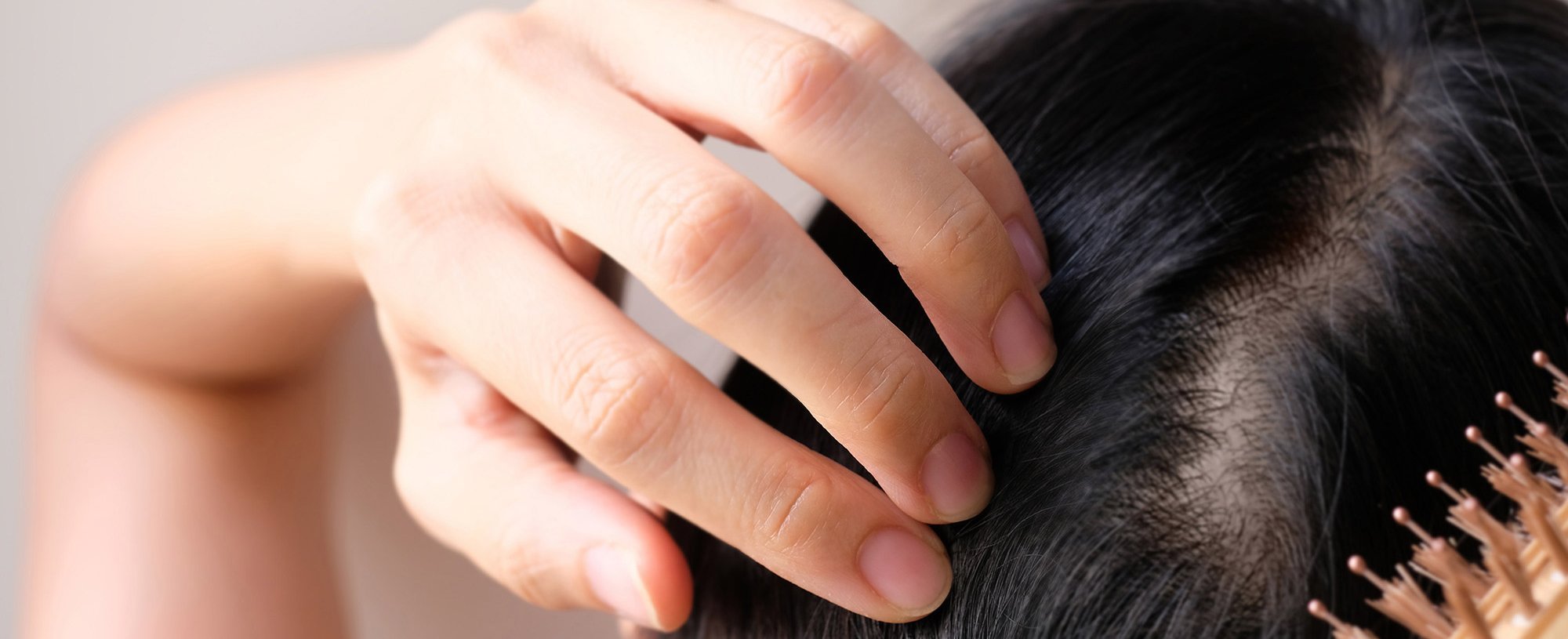While August is National Hair Loss Awareness month, the subject of hair loss in women is still not as widely talked about as it should be throughout the year. Since politicians, celebrities and other public figures have been more open about their experiences with hair loss in the past few years, the topic has become less taboo. Not to mention that the bald head was a popular hairstyle trend for the last two summers, making it less shocking to see women sporting clean shaven heads, regardless of the reason.
But a bald head may only be a fierce fashion statement if you live in a major city — and many women still suffer from different types of hair loss, including traction alopecia and alopecia areata, without seeking counsel. That makes it hard to understand what you’re dealing with, which in turn makes it hard to understand your treatment options (or whether there is any treatment at all). So we’re sharing some signs of hair loss, as well as breaking down several types of alopecia, what causes alopecia, and what treatment options are available.
What Is Alopecia?
You may already know that hair goes through phases: anagen (growth), catagen (transition), telogen (rest) and exogen (hair shedding). When hair is in the exogen or shedding phase, it’s normal for you to lose several hairs (up to 100) per day. It’s also expected for those hairs to be replaced by new hairs within the same follicle. When you’re only experiencing hair loss with no new hair growing in its place, it's considered hair loss, or alopecia.
According to the Mayo Clinic, alopecia can be concentrated on just your scalp or affect your entire body. This type of hair loss can appear in many different ways, depending on what's causing it, and can come on suddenly or gradually.
Signs and Symptoms of Hair Loss
While different types of alopecia have different causes, as per the Mayo Clinic, there are some common signs and symptoms of hair loss that you can look out for.
1. Gradual thinning on top of the head.
This is the most common type of hair loss, affecting people as they age. In men, hair often begins to recede at the hairline while women typically have a broadening of the part in their hair.
2. Circular or patchy bald spots.
Some people lose hair in circular or patchy bald spots on the scalp, beard or eyebrows, with the skin becoming itchy or painful before the hair falls out.
3. Sudden loosening of hair.
A physical or emotional shock or traumatic event can cause hair to loosen. Handfuls of hair may come out when combing or washing your hair. This type of hair loss usually causes overall hair thinning but is often temporary.
What Causes Alopecia?
Hair loss can be related to several factors, including medications, certain autoimmune conditions, heredity and even hairstyle choices. Dermatologists and hair specialists have been studying forms of alopecia for years to identify their causes. While some causes are still unknown, here are some common types of alopecia you should know, their causes, and possible treatment options.
1. Traction Alopecia
According to the Skin of Color Society, traction alopecia is a form of hair loss in which pulling or tension causes mechanical damage to the hair follicle. It’s typically caused by high-tension hairstyles such as tight braids, weaves, and tight ponytails. Small, flesh-colored or white bumps will often form around the area where the hair is pulled too tight, followed by scalp tenderness and eventually symmetrical hair loss.
Traction alopecia can appear gradually, making it difficult to reverse any permanent damage if hairstyling habits are unchanged. The best prevention for traction alopecia is to wear no- to low-tension hairstyles and also reduce the use of chemicals in hairstyling.
2. Alopecia Areata
One of the most widely known forms of hair loss, alopecia areata is a disease in which the immune system attacks the hair follicles, as per the National Institutes of Health (NIH). Hair typically falls out in small, round patches but it can be more extensive and can differ per person.
Hair loss begins on the scalp and can affect other parts of the body, including the eyebrows and eyelashes. There are no drugs currently approved to treat this form of hair loss, but patients have seen success in treating it with medications for other conditions. Alopecia totalis and alopecia universalis are different forms of alopecia areata.
3. Central Centrifugal Cicatricial Alopecia (CCCA)
This form of scarring alopecia presents as patches of permanent hair loss that begins at the crown of the head, and spreads outward, as per the National Center for Biotechnology Information (NCBI). While the source of this type of hair loss is unclear, some suggested causes include infection, autoimmune disease and genetics — but more studies need to be done to confirm these hypotheses. According to the Skin of Color Society, this type of hair loss has been most commonly seen amongst Black women.
4. Frontal Fibrosing Alopecia
This increasingly common hair loss pattern is mostly found in older women and is marked by a receding hairline, according to the Mayo Clinic. It causes scarring hair loss, meaning the hair will not grow back. Women have been known to see hair loss in the eyebrows before the hairline begins to recede. Early treatment can help slow down recession and prevent permanent baldness.
5. Androgenetic Alopecia
This inherited hair loss is genetically predetermined as per the NCBI, and occurs when the anagen cycle becomes shorter and shorter. The hair follicles sprout hairs that are thinner than normal and eventually the follicles wither away. In men, hair loss is most prominent at the hairline and crown while women typically see diffuse loss at the crown of the head.
This form of hair loss is often treated with FDA-approved topical minoxidil and finasteride (a type 2 inhibitor with unclear efficacy in treating female pattern baldness, and alarming adverse effects). Many people have reversed their hair loss with the use of topical treatments like minoxidil, and other solutions such as corticosteroids, JAK inhibitors and other medications that stimulate hair growth.
If you’re experiencing hair loss, it’s important that you seek the guidance of a professional in order to understand your hair loss and to determine the best treatment option for you.
Next: Beauty Myth Busters: 4 Hair Loss Myths You Need to Stop Believing, Stat
Written by: Shalwah Evans, Photo Credit: iStock







